
© Marion Lafogler
To meet the growing demand for sheltered dwellings in the Puster Valley in South Tyrol (Alto Adige), the public authorities held a competition in 2004 for a proposed extension to their existing nursing home in Bruneck. A central requirement was the creation of accommodation and open areas for people suffering from dementia.
During the period of implementation, which lasted a good six years, the architects made a close investigation of innovative concepts of care for the elderly. The outcome of this was a new structure that was carefully integrated into the small-scale fabric of neighbouring housing. With its brown, rendered facade and sculptural form, the development radiates a sense of calm and restraint, even though it is based on a heterogeneous user concept with diverse internal and external spatial relationships.
The internal spaces are distinguished by closely coordinated colours, forms and lighting as well as by furnishings and fittings designed by the architects. People with dementia are often quite mobile, but suffer from a lack of bearings. The calm environment created here provides residents with a sense of stability and orientation as well as the feeling that they belong to a community. This applies in particular to the “care oasis”, a kind of open-plan nursing station for eight permanently bedridden patients suffering from advanced dementia.
During the period of implementation, which lasted a good six years, the architects made a close investigation of innovative concepts of care for the elderly. The outcome of this was a new structure that was carefully integrated into the small-scale fabric of neighbouring housing. With its brown, rendered facade and sculptural form, the development radiates a sense of calm and restraint, even though it is based on a heterogeneous user concept with diverse internal and external spatial relationships.
The internal spaces are distinguished by closely coordinated colours, forms and lighting as well as by furnishings and fittings designed by the architects. People with dementia are often quite mobile, but suffer from a lack of bearings. The calm environment created here provides residents with a sense of stability and orientation as well as the feeling that they belong to a community. This applies in particular to the “care oasis”, a kind of open-plan nursing station for eight permanently bedridden patients suffering from advanced dementia.






